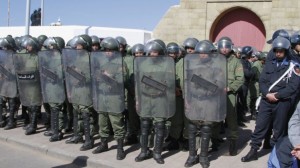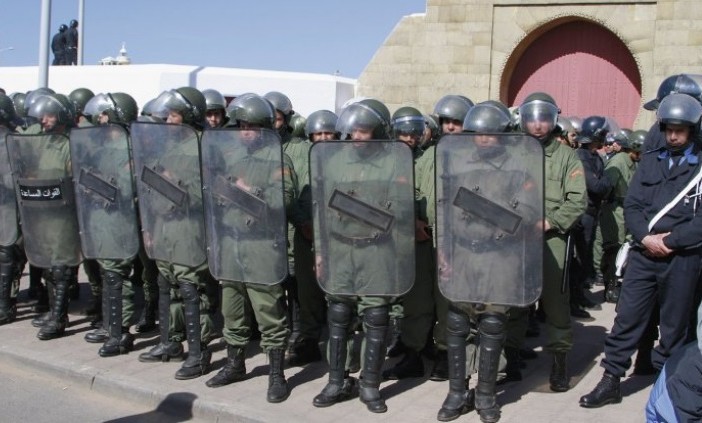Ludovico Carlino
IHS Jane’s Intelligence Review

Moroccan police block the entrance to the Martyr’s Cemetery in Rabat, Morocco, on 26 March, to prevent the funeral of the widow of the leader of the Islamist Al-Adl wal Ihsan group. Source: PA
Key Points
- The arrests come after another pro-Islamic State militant cell in Salwane, near the north-eastern city of Nador, was dismantled on 13 April as part of a series of raids that have targeted suspected Islamic State supporters in major cities in the last few months.
- Morocco has to date served primarily as a logistic transit point for jihadists’ smuggling activities, rather than a theatre for jihad. However, recent counter-terrorism operations across the country indicate a shift in jihadist strategy.
- Although no established jihadist group has been identified in Morocco, connections between Islamic State units in North Africa and Morocco-based jihadist cells are likely to increase the latter’s attack capabilities, raising terrorism risk in the six-month outlook.
EVENT
Morocco’s Interior Ministry on 16 April announced the detention of two militants in the western city of Safi, Doukkala-Abda province, who were allegedly planning attacks in the country on behalf of the Islamic State.
According to the Interior Ministry’s statement, the six Islamic State supporters arrested in Salwane on 13 April planned to kidnap security force members and politicians, then behead them or burn them alive on film. Their strategy was reportedly to use small-arms to attack isolated soldiers, kill them, then steal their weapons, later using those weapons to stage bigger attacks. Moroccan authorities also stated that the cell had established a small mobile training camp in the hills surrounding Salwane, where the militants were trained in the use of weapons and explosives.
The detection of the Salwane cell is the latest in a series of counter-terrorism operations that have targeted suspected Islamic State supporters in major cities. On 25 March, the Central Bureau of Judicial Investigation, a new judicial body established by the government as part of the amended anti-terrorism law adopted by the parliament in January, announced the dismantling of another militant network spread over several cities, including the tourist resort of Agadir in southwest Morocco, Marrakesh, Boujaad, Tangiers in the north and Ain Harouda, near Casablanca. On 1 April, security forces arrested 13 people in Fez, accused of belonging to a cell recruiting young Moroccans to fight with the Islamic State in Syria and Iraq.
Logistic transit point
Morocco has not been affected by the same level of organised jihadist activity as seen in Algeria, Egypt, Libya, or Tunisia. Security forces are experienced in counter-terrorism operations, and are effective at disrupting isolated militant cells, while a new framework of intelligence co-operation with Spanish authorities, which retain the enclaves of Ceuta and Melilla, has enabled security services to detect terrorist plots in their early stages. Additionally, the general pattern of organisation for Moroccan militants has been small independent militant cells coalescing around individuals with strong connections to local criminal networks and personal affiliations with jihadists active across the North African region, Syria, and Iraq. This pattern facilitated the role played by Morocco as a logistic transit point for jihadists’ smuggling activities across the region as well as a recruitment hub for jihad abroad.
In a February report, Spanish and Italian judicial authorities pointed out that 19 ships carrying approximately EUR381 million (USD412 million) worth of hashish and cocaine were seized in the eastern Mediterranean during the last two years, and it is likely that the majority of this cargo was intended to finance jihadist activities. All the ships began their journeys in Morocco. Additionally, more than 1,600 Moroccans have travelled to Syria, Iraq, and Libya to join jihadist groups there, according to the most recent estimates provided by the Interior Ministry; the number is still one of the highest in the region. In Syria, the majority of Moroccans jihadists end up joining Harakat Sham al-Islam, a ‘brigade’ close to Al-Qaeda affiliate Jabhat al-Nusra, which is made up of Moroccan foreign fighters in Syria and is led by former Moroccan jihadist and Guantanamo detainee, Brahim Maâzouz.
Gradual shift
Morocco-based and trans-national jihadists probably still consider Morocco a valuable asset for their smuggling activities, especially due to the relative ease of reaching European black markets through the Spanish enclaves of Ceuta and Melilla. Nevertheless, IHS data indicates that approximately 90 suspected jihadists were arrested between September 2014 and April 2015, with recovered information indicating persistent jihadist intent to launch attacks inside the country. Similarly, IHS social media monitoring has shown Moroccan jihadists hardening their rhetoric, particularly after the Moroccan government’s decision in November 2014 to join the military coalition in Iraq and Syria against the Islamic State. After the announcement, Moroccan jihadists reportedly issued threats against the King (accusing him of “apostasy”) and openly calling for attacks against tourist resorts in the country such as Agadir and Essaouira. Similarly, Islamic State affiliates in North Africa are likely to consider Morocco as a fertile ground for new recruits, and as a potential new theatre in which to expand their operations. On 26 January, security forces arrested an envoy of the pro-Islamic State group Jund al-Khilafah fi Ard al-Jazaye (Soldiers of the Caliphate in Algeria) near Bni Drar and Ahfir, close to the Algerian border. Islamic State affiliates regularly use envoys to build alliances and prepare the ground for the establishment of local units.
FORECAST
Despite a probable growing terrorist threat in Morocco, there are currently no indications of an established, organised jihadist presence in the country. Instead, militants remain generally confined to small isolated cells or Islamic State support networks. Nonetheless, the 18 March attack on the Bardo Museum in Tunis indicated how individuals with loose connections with domestic groups, but with combat experience and connections with militant groups established abroad, are able to stage high-profile attacks targeting key economic sectors like tourism. In Morocco, the main risk likely stems from returnees who have acquired expertise in military tactics and improvised explosive devices in Syria, Iraq and Libya, However, attacks by isolated pro-Islamic State sympathisers, who have not travelled abroad, are becoming increasingly likely in the six-month outlook due to the emergence of a narrative hostile to the state. These attacks would probably involve the use of unsophisticated improvised explosive devices (including incendiary devices) and small-arms, with tourism assets and locations frequented by Western expatriates likely to be at highest risk. Probable hotspots include hotels and restaurants where the concentration of Western tourists is highest, especially in Tetouan, Fez, Agadir, Essaouira, Marrakesh, and Nador.







